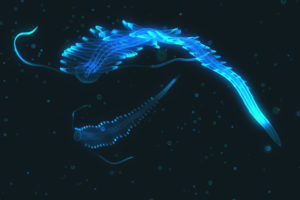
Today’s blog comes to you from the Promega North America Branch Office.
In nature, the ability to “glow” is actually quite common. Bioluminescence, the chemical reaction involving the molecule luciferin, is a useful adaptation for many lifeforms. Fireflies, mushrooms and creatures of the ocean deep use their internal lightshows to cope with a variety of situations. Used for hunting, communicating, ridding cells of oxygen, and simply surviving in the darkness of the ocean depths, bioluminescence is one of nature’s more flashy, and advantageous traits.
In new research published in April in the journal Scientific Reports, MBARI researchers Séverine Martini and Steve Haddock found that three-quarters of all sea animals make their own light. The study reviewed 17 years of video from Monterey Bay, Calif in oceans that descended to 2.5 miles, to determine the commonality of bioluminescence in the deep waters.
Martini and Haddock’s observations concluded that 76 percent off all observed animals produced some light, including 97 to 99.7 cnidarians (jellyfish), half of fish, and most polychaetes (worms), cephalopods (squid), and crustaceans (shrimp).
Most of us are familiar with the fabled anglerfish, the menacing deep-sea creature known for attracting ignorant prey with a glowing lure attached to their head. As you descend below 200 meters, where light no longer penetrates, you will be surprised at the unexpected color display of the oceans’ sea life. Bioluminescence is not simply an exotic phenomenon, but an important ecological trait that the oceans’ sea creatures have wholeheartedly adopted to cope with complete darkness.
Most sea organisms however, display only a dim and intermittent flash of light. This aids in survival in the oceans’ darkest depths without attracting unwanted attention from predators. As a result, previous methods for counting the number of glowing sea creatures have been inadequate. Most cameras could not detect the faint glow of many organisms, and researchers resorted to estimates based on looking out windows of submersibles.
In Martin and Haddock’s latest study, researchers videoed 240 dives in remotely operated vehicles and counted every animal larger than 1 centimeter located between the ocean surface and 4,000 meters deep. They compared their observations with a list of known bioluminescent organisms to reach their estimates.
Not only did the number of bioluminescent organisms surprise researchers, but also the proportion. It is a commonly held view that glowing sea creatures live only in the deepest and darkest corners of the ocean. However, the study concluded that the number of glowing and non-glowing animals remains consistent from the surface to 4,000 meters deep.
However, as you descend deeper into the ocean, the taxonomic make-up of glowing organisms changes. Near the surface, jellyfish are the primary light emitters. In the middle depths, marine worms mainly carry bioluminescence traits; and in the darkest corners of the sea, the ocean’s glow is largely thanks to larvaceans (free-swimming tunicates).
With a majority of the ocean still largely unexplored, the full extent of earth’s glowing animals is yet to be established. Martini and Haddock did conclude that, “Given that the deep ocean is the largest habitat on Earth by volume, bioluminescence can certainly be said to be a major ecological trait on Earth.”
Original Article: https://www.nature.com/articles/srep45750
Related Posts
Latest posts by Promega (see all)
- Beyond Ozempic: The New Frontier of Obesity Research - April 18, 2025
- One Health and H5N1: Promega’s Commitment to Holistic Solutions - April 8, 2025
- Overcoming qPCR Inhibitors: Strategies for Reliable Quantification - March 13, 2025
